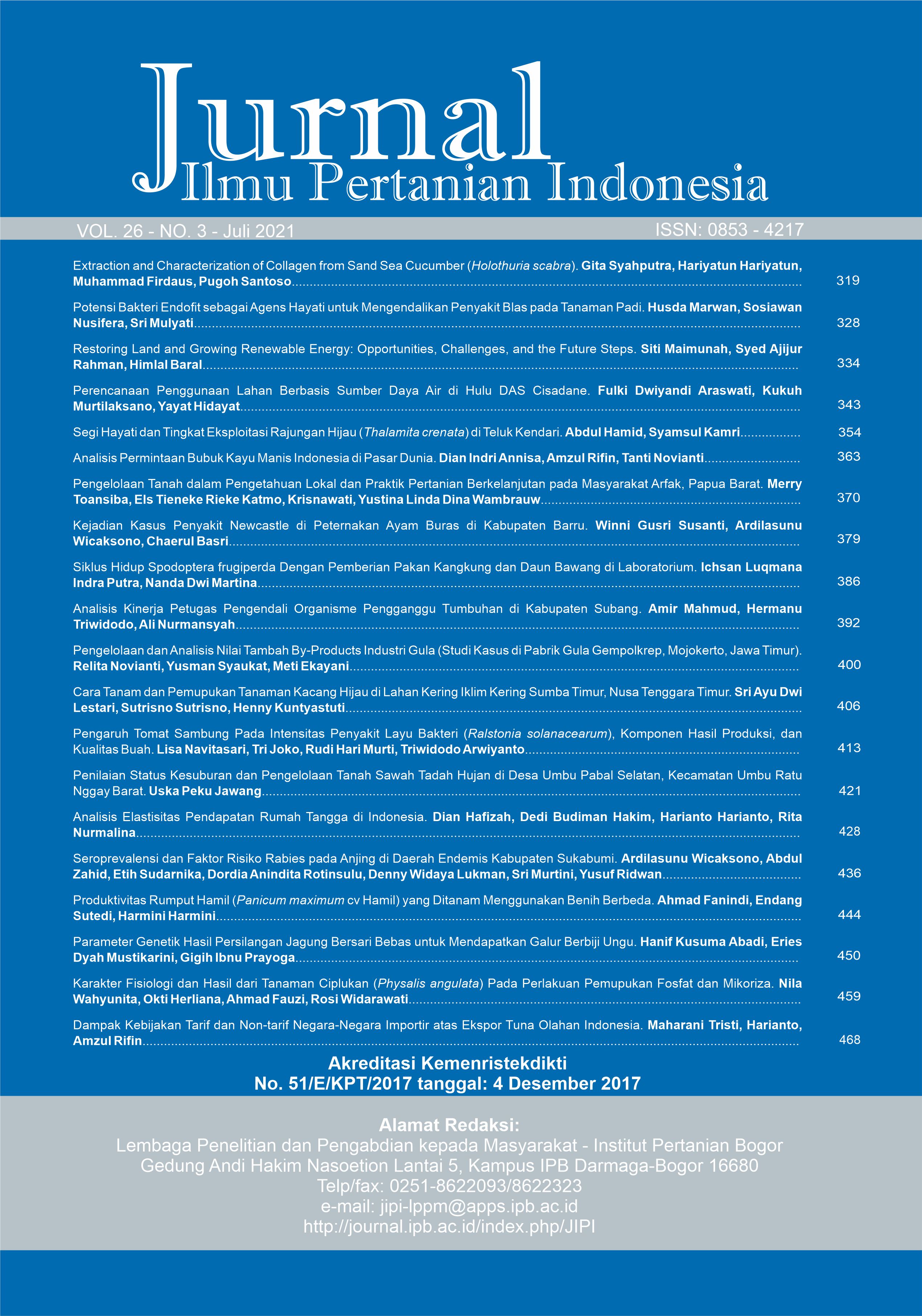Analisis Elastisitas Pendapatan Rumah Tangga di Indonesia
Abstract
Demand for food products is inevitable, this condition is related to food products as a staple food for the sustainability of human life. In Indonesia, the demand for food depends very much on the needs of the people. The purpose of this study is to analyze food demand in Indonesia which is divided into 4 categories of regions: rich cities, poor cities, rich villages, and poor villages need through research that can be obtained about getting assistance in accordance with the consumption demand of people in Indonesia. The research method used secondary data with panel data types obtained from SUSENAS data. The analytical method used to estimate the demand system was through econometrics demand, namely the QUAIDS model and then the data were processed using the SAS program. The results showed a comparison of the total number of households allocated specifically for food if sorted out, namely poor villages were higher then followed by poor cities, rich cities, and rich villages. When there is a change in income, poor rural households and poor cities when the public still responds by allocating a large part of their budgets to very basic trade such as other food and tobacco, rice, other oils, and household fats in rich villages and rich cities provide more responses to allocating their incomes to the trade in meat, fruits, vegetables, fish, eggs, milk, and processed foods.
Keywords: Quadaric Almost Ideal System, income elasticity, consumption, demand food
Downloads
References
Abdulai. 2002. Household demand for food in Switzerland. A quadratic almost ideal demand system. Swiss Journal of Economic Statistics, 138(1): 118. https://doi.org/10.1111/j.1574-0862.2004.tb00222.x
Abdulai, Aubert D, 2004, A cross-section analysis of household demand for food and nutrients in Tanzania.Agricultural Economics. 3 (1): 6779.
Ariningsih E. 2002. Perilaku konsumsi pangan sumber protein hewani dan nabati sebelum dan pada masa krisis ekonomi di Jawa [Tesis]. Bogor (ID): Institut Pertanian Bogor.
Banks J, Blundell R, Lewbel A. 1997. Quadratic Engel curves and consumer demand. Review of Economics and Statistics. 4(1): 527539. https:// doi.org/10.1162/003465397557015
Blundell RW, Robin JM. 1999, Estimation in Large and Disaggregated Demand Systems: An Estimator for Conditionally Linear Systems. Journal of Applied Econometrics, 14(1): 209232. https://doi.org/ 10.1002/(SICI)1099-1255(199905/06)14:3<209:: AID-JAE532>3.0.CO;2-X
Dianarafah D. 1999. Analisis konsumsi pangan di Propinsi Jawa Timur [Tesis]. Bogor (ID): Institut Pertanian Bogor.
Deaton A, Muellbauer J. 1980. An Almost Ideal Demand System. American Economic Review 70(3): 312326.
Fisher D, Fleissig AR, Serletis A. 2001. An empirical comparison of flexible demand system functional forms. Journal of Applied Econometrics, 16(1): 5980. https://doi.org/10.1002/jae.585
Gould W, Villarreal HJ. 2006. An Assessment of the Current Structure of Food Demand in Urban China. Agricultural Economics. 34(1): 116. https:// doi.org/10.1111/j.1574-0862.2006.00098.x
Harianto. 1994. An empirical analysis of food demand in Indonesia: a crosssectional study [Dissertation].Victoria (US). La Trobe University.
Nicholson W, Snyder C. 2007. Microeconomic Theory : Basic Principles And Extentions. South-Western (US) Thomson Corporation.
Meenakshi JV, Ray R., 1999. Regional Differences in India’s Food Expenditure Pattern: A Completed Demand Systems Approach. Journal of International Development. 11(1): 4774. https:// doi.org/10.1002/(SICI)1099-1328(199901/02)11: 1<47::AID-JID549>3.0.CO;2-Y
Miranti A, Syaukat Y, Harianto. 2016. Pola konsumsi pangan rumahtangga di Provinsi Jawa Barat. Jurnal Agro Ekonomi. 34(1): 6780. https://doi.org/ 10.21082/jae.v34n1. 2016.67-80
Mittal, Surabhi. 2008. Application of the Quaids Model to the Food Sector in India. Journal of Quantitative Economics. 8(1): 3642.
Molina JS, Gil AI. 2005. The Demand Behavior of Consumers in Peru: A Demographic Analysis using the QUAIDS. Journal of Developing Areas. 39(1): 191206. https://doi.org/10.1353/jda.2005.0038
Moro D, Sckokai P. 2000, Heterogenous Preferences in Household Food Consumption in Italy. European Review of Agricultural Economics. 27(3): 305323. https://doi.org/10.1093/erae/27.3.305
Pangaribowo EH, Tsegai D. 2011. Food demand analysis of Indonesian households with particular attention to the poorest. ZEF-Discussion Papers on Development Policy No. 151. Zentrum für Entwicklungstorschung, Center for Development Research. Bonn (DE): University Bonn.
Rachman HPS. 2001.Kajian pola konsumsi dan permintaan pangan di Kawasan Timur Indonesia [Disertasi]. Bogor (ID): Institut Pertanian Bogor.
Saputri R, Lestari LA, Susilo J. 2016. Pola konsumsi pangan dan tingkat ketahanan pangan rumah tangga di Kabupaten Kampar Provinsi Riau. Gizi Klinis Indonesia. 12(3): 123130. https://doi.org/ 10.22146/ijcn.23110
Suharno. 2010. An almost ideal demand system for food based on cross section data: rural and urban East Java, Indonesia [dissertation]. Göttingen (DE): Georg-August-Universität Göttingen.
Wahyuni D, Purnastuti L, Mustofa. 2016. Analisis elastisitas tiga bahan pangan sumber protein hewani di Indonesia. Jurnal Economia. 12(1):4353. https://doi.org/10.21831/economia. v12i1.9544
Widiasih SCL. 2009. Analisis konsumsi dan kebutuhan untuk konsumsi pangan di Provinsi Sumatera Barat, Jawa Tengah, dan Sulawesi Tenggara Tahun 2005-2015 [Tesis]. Bogor (ID): Institut Pertanian Bogor.
Yuliana R. 2008. Evaluasi perubahan tingkat kesejahteraan rumahtangga sebagai dampak kenaikan harga BBM di Indonesia, periode Pebruari 2005–Maret 2006 [tesis]. Depok (ID): Universitas Indonesia
Yusdiyanto S. 2016. Pola konsumsi pangan rumahtangga miskin di Provinsi Sulawesi Tengah [tesis]. Bogor (ID): Institut Pertanian Bogor.
This journal is published under the terms of the Creative Commons Attribution-NonCommercial 4.0 International License. Authors who publish with this journal agree to the following terms: Authors retain copyright and grant the journal right of first publication with the work simultaneously licensed under a Creative Commons Attribution-NonCommercial 4.0 International License. Attribution — You must give appropriate credit, provide a link to the license, and indicate if changes were made. You may do so in any reasonable manner, but not in any way that suggests the licensor endorses you or your use. NonCommercial — You may not use the material for commercial purposes.






















